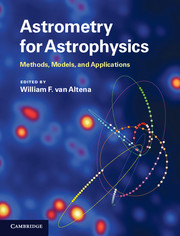Book contents
- Frontmatter
- Contents
- List of contributors
- List of acronyms
- Preface
- Part I Astrometry in the twenty-first century
- Part II Foundations of astrometry and celestial mechanics
- Part III Observing through the atmosphere
- Part IV From detected photons to the celestial sphere
- 13 Geometrical optics and astrometry
- 14 CCD imaging detectors
- 15 Using CCDs in the time-delay integration mode
- 16 Statistical astrometry
- 17 Analyzing poorly sampled images: HST imaging astrometry
- 18 Image deconvolution
- 19 From measures to celestial coordinates
- 20 Astrometric catalogs: concept, history, and necessity
- 21 Trigonometric parallaxes
- Part V Applications of astrometry to topics in astrophysics
- Index
- References
17 - Analyzing poorly sampled images: HST imaging astrometry
from Part IV - From detected photons to the celestial sphere
Published online by Cambridge University Press: 05 December 2012
- Frontmatter
- Contents
- List of contributors
- List of acronyms
- Preface
- Part I Astrometry in the twenty-first century
- Part II Foundations of astrometry and celestial mechanics
- Part III Observing through the atmosphere
- Part IV From detected photons to the celestial sphere
- 13 Geometrical optics and astrometry
- 14 CCD imaging detectors
- 15 Using CCDs in the time-delay integration mode
- 16 Statistical astrometry
- 17 Analyzing poorly sampled images: HST imaging astrometry
- 18 Image deconvolution
- 19 From measures to celestial coordinates
- 20 Astrometric catalogs: concept, history, and necessity
- 21 Trigonometric parallaxes
- Part V Applications of astrometry to topics in astrophysics
- Index
- References
Summary
Introduction
Space observatories, such as Hubble Space Telescope (HST), Spitzer, and Kepler, offer unique opportunities and challenges for astrometry. The observing platform above the atmosphere allows us to reach the diffraction limit with a stable point-spread function (PSF). The downside is that there are limits to how much data can be downloaded per day, which in turn limits the number of pixels each detector can have. This imposes a natural compromise between the sampling of the detector and its field of view, and in order to have a reasonable field of view the camera designers often tolerate moderate undersampling in the detector pixels.
A detector is considered to be well sampled when the full width at half maximum (FWHM) of a point source is at least 2 pixels. If an image is well sampled, then the pixels in the image constitute a complete representation of the scene. We can interpolate between the image pixels using sinc-type functions and recover the same result that we would get if the pixels were smaller. This is because nothing in the scene that reaches the detector can have finer detail than the PSF. On the other hand, if the image is undersampled, then there can be structure in the astronomical scene that changes at too high a spatial frequency for the array of pixels to capture completely.
Some of the information that is lost to undersampling can be recovered. One common strategy to do this involves dithering. By taking observations that are offset from each other by sub-pixel shifts, we can achieve different realizations of the scene. These realizations can be combined to produce a single, higher-resolution representation of the scene that contains more information than any single observation. “Drizzle” is a popular tool that was produced by the Space Telescope Science Institute (STScI; Fruchter and Hook 1997, 2002) to combine multiple dithered pointings into a single composite image.
- Type
- Chapter
- Information
- Astrometry for AstrophysicsMethods, Models, and Applications, pp. 257 - 264Publisher: Cambridge University PressPrint publication year: 2012



